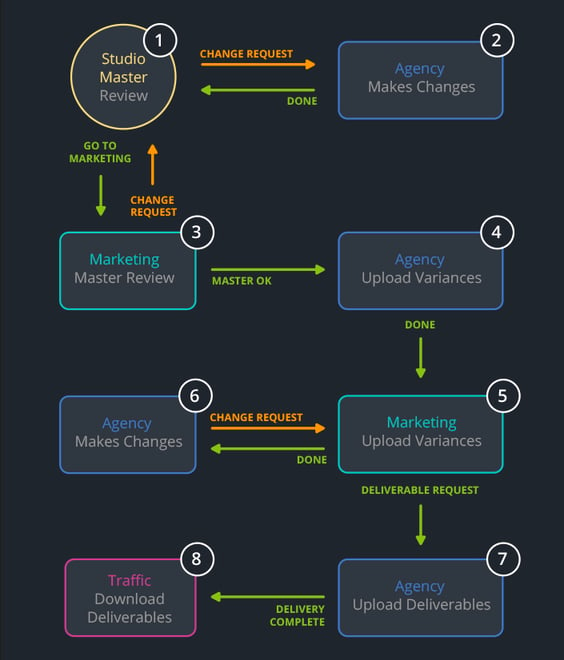
Find out how one of the world's most recognizable lux brands, Armani, worked with Aproove to overcome critical business challenges. Armani expanded on Aproove's existing online proofing capabilities and embraced Aproove's workflow automation and form capabilities to dramatically speed up the project lifecycle, standardize processes and cut costs.

Before adopting Aproove in 2014, Armani would choose three photography shots per campaign;
The three images would then have localized variants produced for the global market before becoming part of the master asset pack allowing the campaign production to start. Armani would also receive Cromalin's (hard proofs) from the external agencies. The Cromalin's were supplied via couriers, which caused several challenges;
The main objective in 2014 was to cut production cycle times, reduce cost, expand capacity and increase the pool of external agency talent Armani could use.
With Aproove's color management engine and Adobe libraries, Armani was confident that what they see on screen would be represented in print or online. The photography selection, revision cycles, and final proof sign-off were dramatically reduced upon adopting Aproove.
However, Armani’s preference was to have physical contract proof at the final sign-off stage. Using Aproove's contract proof option, Armani could now instruct external agencies to automatically send proofs via an Aproove task directly into Armani's “in-house” collaborated Epson printers for final proof sign-off.
This ability meant that Armani could now utilize external freelancers that did not have access to high-end proofing equipment, and it also totally removed the need for couriers. Using Online Proofing up until the final contract proof stage was the perfect balance for Armani provided three instant results;
The courier savings alone was enough for Armani procurement to justify the investment in Aproove; couple this with the time savings and increased productivity Aproove was an easy decision to make.
By adopting Aproove, Armani had much more production capacity. This extra capacity was very much welcome as the multi-channel marketing requirements expanded from print to online and social media, all with much faster turnaround times. Armani now produce;
3
"Egérie" Images
(instead of one)
12
"Point of Sale"
Product images
(instead of three)
+450
Localized Variances
From the 15 images per campaign
Global
Distribution
with many new emerging markets added
The modern world for retailers was already changing at a pace. Still, with the introduction of Covid-19 and a global pandemic, Armani quickly needed to adapt to a mobile workforce.
Armani was aware that Aproove had evolved and was offering much more than just Online Proofing. With the introduction of dashboards, task management, workflow automation, and business process management, it was time for Armani to re-visit Aproove Work Management to explore what further business challenges it could solve both upstream and downstream in the production process.
Armani used email, spreadsheets, and manual processes to start projects and monitor the progression throughout the project life cycle. The Studio, Marketing, Traffic, and external suppliers all had independent workflows. The project progression becomes invisible to each team until it was within that team's remit.
This manual way of working did not give centralized visibility of a project's progression. It relies heavily on individuals to keep projects moving with no early warning indicators or central visibility of all ongoing projects for management purposes.
This problem got amplified when the internal stakeholders were suddenly working remotely, and the external suppliers were also in the same position. Now, more than ever, these processes needed to be streamlined, automated, and centrally visible to avoid delays and mistakes.
Having the required task drop into a stakeholder's "to-do" list with a specified deadline along with the tools to carry out the task is where Aproove adds enormous value. All those processes got automated as part of a more extensive workflow. The workflow itself can get driven by decisions and actions taken by the stakeholders.
This granular business process control level allowed Armani to centralize the review and approval process and the entire business processes for the Studio, Marketing, Traffic, and external suppliers. Mapping each team's business process into decision-based workflows, making them automated and highly visible from a central dashboard along with automatic reminders and early warning indicators to ensure deadlines get met and conflicts quickly resolved.
Another time-consuming challenge was collating all of the files sent back from the external studios. The files were sent back via disks, FTP, email, and via applications such as DropBox. The filenames were often not relevant for Armani. All the files needed to be collated, manually opened (for identification), and then renamed before they were stored in the appropriate place. This process was highly time-consuming and frequently led to confusion and much manual intervention.
Forms were one of the most attractive features to Armani. Forms appear simple (which is the objective), but they can mask vast amounts of business complexity.
For the end-user, a form is an effortless data entry and upload point. Each form can be customized to its appropriate audience and presented anywhere in the workflow where data is required. The business information entered by any user can even get stored as metadata to guide the workflow automatically.
Armani saw the value of forms and asked Aproove to expand this functionality. If Aproove could develop the forms further, it would allow them to remove ad-hoc, de-centralized, manually generated spreadsheets from the workflow.
First, meet the stakeholders




The Armani Marketing team deals with many new products that are constantly changing or evolving. The Marketing team continuously requires new photography shots, and those shots need retouching, localization, and incorporation into the wider marketing campaigns for online and offline campaigns.
The Armani Marketing team needed to provide the Armani Studio with Campaign instructions to enable the Studio to start working; however, this process had no standardization. Each Marketing Team member took a different approach. The information could come via email, sticky notes, or, at best, a spreadsheet.
Due to the complexity of information that Studio required to start a project, the spreadsheet approach seemed the most logical way to standardize the delivery of necessary information.
The manual spreadsheets were effectively Studio “job instruction tickets,” which were, of course, vital to the project. The downside of these manual spreadsheets was that they were extremely time-consuming to complete, decentralized, prone to human error, and offered no automation.
Although Armani had taken the first step to standardize the job instruction briefings to the Studio (via the spreadsheets), they knew further work was required. This critical process added time to the project life cycle and was wasting much energy.
Introducing the Aproove "Grid-Form" Function!
Aproove worked with Armani to understand the use case and incorporate spreadsheet-like functions into Aproove’s existing form feature.
This allowed the Marketing team to initiate a project by filling out a form which would then be used to kick off the job in Studio. This approach meant that the job instruction delivery was always in a standard format, initiated by an online form that kicked off the workflow and notified stakeholders automatically.
However, this was only partially helping because the form still needed to be populated by the Marketing team, which is very time-consuming and open to human error. Aproove, working alongside Armani, identified and created several “pre-filled” grid forms for different project types, e.g. Skincare, Perfume, Cosmetic. The Marketing Team would select what form was appropriate for the project, and all the fields were already pre-populated based on a “typical” project of that nature. This meant that the Marketing Team only needed to tweak the form (if required) rather than fill it out each time.
Further expanding this, Aproove also identified that some of the variables used in the drop-down options were not always necessary based on previous field selection and so incorporated “dynamic fields” that get populated based on previous choices. All of this granular control is available to the Aproove Administrator, allowing them to expose relevant and custom business forms at the correct stage of a workflow controlled by permissions and automation.
Once the form was completed, Aproove automatically sent task notifications to the chosen external studio, and the task included the job instructions provided in the form. To complete the task, the external studio has to upload the files commissioned by the Armani Marketing team.
But how did Armani streamline the collection of files with the correct naming convention?
Aproove has always supported "naming conventions" using regular expressions; however, Aproove upgraded this feature allowing Armani to enforce the file naming and provide clear information if a file does not meet the required naming standards. Explaining the reason why the file is named incorrectly and how to resolve it dramatically reduced support requests from the external studios.
Now the files were named correctly, they could automatically get filed. Naming conventions also allow Armani to control who can see what files based on the file name itself.
This feature was a huge time saver for Armani.
This video showcases the naming convention feature in action.
The video is an extract from the Aproove "Metadata & Forms" Webinar held in May 2021.
The complete "Forms and Metadata" Webinar is found here, and it also showcases the "form grid" function.

Once the Aproove “Form Grid” is complete, all the data is stored as metadata inside the Aproove database. This information can be used to drive the workflow and populate “variable” fields during the workflow.
Once the form was completed, the project is kicked off, and we enter the Business Process Workflow shown below; (Please note; This example workflow is basic and Armani have many more complex workflow scenarios)
In the form, the Marketing Team instructs what external agency will be used and checks the "shot list" is accurately filled out.
The external Studio receives an automated email from Aproove instructing what products need to get shot along and the job instructions. That information is extracted from the form data filled in by the Marketing Team.
The photography studio also receives an “upload” task allowing the Studio to drag and drop the files requested by Armani directly into the workflow using the correct naming convention.
Once the external Studio sends the files back, they automatically go into a review cycle between the Armani Studio and the external Studio (steps 1&2). This review cycle can happen as many times as required until the Armani Studio selects the “send to marketing” option, which moves the files/s into step 3 of the workflow.
Step 3 is where the Armani Marketing team checks the photography and retouching completed by both the external supplier and Armani Studio. If the Marketing team requires changes, they reject the file, which moves it back into steps 1&2. If they approve the master, it moves the workflow into step 4.
In Step 4, the master enters the “variance” stage, handled exclusively by the Amani Marketing Team and external agencies.
Upon approval (step 3), the external agency automatically sends the master file/s to create the regional variances (step 4). Again, Aproove automates this process by using the data populated in the form at the beginning of the workflow and provides the external agency with the file, necessary job instructions, and an upload task to send back the variances.
Once the agency uploads the regional variances, the workflow enters step 5, where the Armani Marketing team checks the uploaded work. If they request changes, it moves to step 6, an approval loop between the external agency and Armani Marketing. Once the Marketing team approves the variance, it moves to step 7.
Steps 7&8 invoke the Armani Traffic team. The Traffic Team is sent the master file/s to check them and ensure they meet the Armani specification. They will keyword the files and store them in the Armani Digital Asset Management System.
Aproove can connect to external file systems, PIMs, or ERP systems allowing interaction with other business-critical systems from within the Aproove interface.
This gives Armani the potential to populate forms with assets stored on the internal DAM when reviewing files inside the Aproove interface.
Armani is actively building other mission-critical workflows that will be adopted throughout the business during the course of 2021. Armani will soon be able to leverage Aproove’s Adobe and Microsoft plugins that allow operators to see annotations created by reviewers in real-time directly inside the application. Furthermore, Aproove is also adding the capability to send automated tasks to desktop publishers. That task will contain a link to open the annotated file where the annotations will get displayed in the DTP interface such as Photoshop or InDesign. This plugin can be used by internal or external staff.
Aproove Work Management provides powerful workflow and task management functions that task the users (like Project Management Tools); it provides the tool to carry out the job. With the introduction of resource management, Aproove is a one-stop shop for any production facility.
The purpose of this case study is to expose the power of forms within a workflow.
Forms can drive entire workflows and can easily mask complex business processes behind simple forms invoked anywhere in a workflow. The data that is input can get used to route the workflow and populate variable fields.
The power of the forms is vast and offers business streamlined automation that can drive workflows with accuracy, saving vast amounts of time and money.
In this basic example, we only expose a straightforward workflow. Armani has many other workflows running in parallel.
Please review the "Forms and Metadata" Webinar, which showcases the power of forms and metadata in your workflow.